Text
Hey, all. I'm so sorry about the radio silence for the past few months, and I wanted to drop by real quick to give you all a little update. I'm afraid it's going to be pretty quiet around here for a while, and I've come back to a lot of worried messages so I wanted to keep you all in the loop.
I've recently had some pretty big family things going on - my grandma has been moved into hospice care. It's obviously taking up a lot of my time as I want to spend time with her, and my venom lab has been amazing about letting me pick up as many shifts as I want so I can have a little extra income to help my family with bills. I just don't have a lot of free time right now, and it'll probably stay that way for the immediate future.
I'm okay, and the snakes are all good. We celebrated Miriam's third birthday in February! This blog has always been so much fun to run, and I'm going to try to be back as soon as I can because this has always been such an amazing stress-relief to answer your questions and talk about snakes together. For now, though, the askbox is off (I just don't want things piling up too much while I'm gone), and I wouldn't expect to hear from me for a while.
Hoping to be back soon.
570 notes
·
View notes
Note
can snakes dilate their pupils? :0
Yes! It can be hard to see with some snakes but their pupils do dilate depending on light conditions.
Here's my buddy Hobie as an example. Short-tailed pythons have slit pupils:
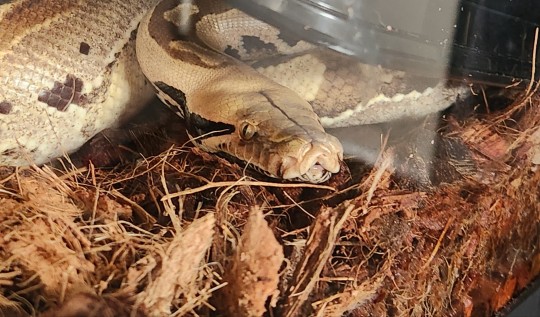
But often, because of light conditions in the room he's in, his pupils look like this:
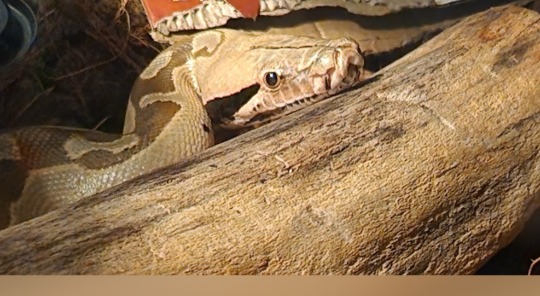
513 notes
·
View notes
Text

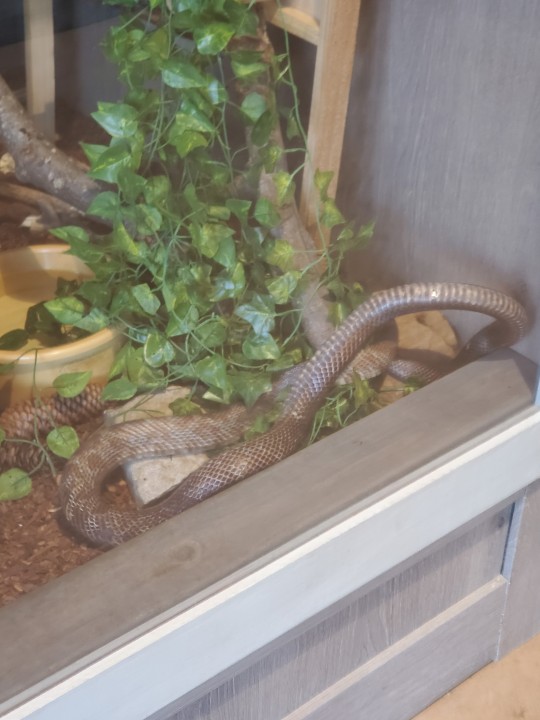
I don't need a rating since this is an ambassador animal at my local wildlife rehab, but I had to share this poor sad unenriched beast that has nothing better to do than try to scale the smooth wall apparently (with bonus aftermath of the tumble) 😂 gotta wonder what goes through their silly little heads when they do something like this when there's clearly a perfectly climbable wall right there. I feel like this is the snake equivalent of getting your cat a lovely toy fit for all their preferences and they'd much rather bat around the tag that came attached to it.
--
What a goofy baby! You can plan out the best enrichment in the world and your ratsnake is STILL gonna try to climb the bare wall right next to it.
339 notes
·
View notes
Note
Hello, big fan of your blog! I was wondering if you have much experience with Mexican Black Kingsnakes? Would you consider them any more difficult in temperament or care than a CA king for a first time snake owner?
Hello hello! I have plenty of experience with MBKs and Cali kings, and they're both great picks. In general you're looking at a very similar experience with both! The biggest difference is that, depending on where you live, MBKs can be a bit harder to find.
Both like moderate humidity, around the 40-60% range is great, and a hot side around 85-88 F. These are super simple perimeters to maintain and even first-time owners rarely have problems with these two species. You'll rarely have issues feeding either species, too! Cali kings can get a bit bigger but you're still looking at about a 3-4 foot snake on average with both species. MBKs can be more recusive when young but as they grow you'll probably see them out and about just as much as Cali kings.
In my experience with own snakes, MBKs tend to be a little bit more introverted and a little less prone to mistaken feeding bites than Cali kings. MBKs can be more flighty and nervous in general. Both of them usually grow out of flightiness as they get bigger, though, and by adulthood they're both usually absolute dreams to handle. Cali kings don't always grow out of trying to put everything in their mouths to see if it's food, while I tend to see MBKs (while still having an excellent food response) are a bit less prone to trying to eat your fingers.
They're both great choices for a first snake. I love my Cali kings and my MBK to death! They're both active, super fun snakes, and I couldn't recommend them enough! They tend to be very low-stress pets; their care is pretty easy, they always eat, and you never have to worry about them.
104 notes
·
View notes
Note
It's Monday! How is Miriam?
Got a bit busy this week, so we're celebrating Miriam Mwednesday today. It's almost food time, so she's been "hunting" around her enclosure the past few days!

299 notes
·
View notes
Note
Hey I love your blog, hope you are well! This is the snake that is supposed to have killed the baddie in a Sherlock Holmes story, do you know what kind of snek it is?

Florida kingsnake. Harmless and adorable!
269 notes
·
View notes
Note
Is a 120 gallon ok for an adult .less than 5 feet ball python? She is an adult and fully grown every where I look it says 120 Is a good tank for adult female ball python.
A 120 gallon is fine, that's a perfectly acceptable minimum enclosure size for a ball python. However, if you can go bigger, by all means do so! Your snake will use every inch of space you give her, and bigger is always better!
104 notes
·
View notes
Text
Thanks for tagging me! Yeah, this is fine. That's a Trans Pecos ratsnake, a blond morph specifically!
Trans Pecos rats are great - my guy Stede is an absolute blast!
3K notes
·
View notes
Note
Hi! I was looking at pictures of crocodiles looking flat and SO SO COMFY and I noticed that some of them look like they've got a bit of pudge in the neck area (outlined). I'm just curious - is there a particular reason they look like that?

That's just fat! One of the places crocodilians store fat is around the neck, so when they lay down and get comfy it kind of pudges out to the sides.
You can see it on bigger crocodilians when they're not laying flat, too, if you get the right angle:
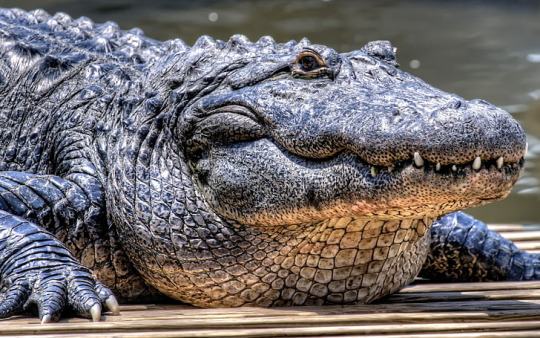
2K notes
·
View notes
Note
How uncomfortable is it for a snake to be milked of its venom? I've seen videos of it, and sometimes it looks like people have to really squish their heads to get the venom out.
I guess I'm just curious/concerned about how the animal is treated in the process of extracting venom and would love some insight, if that's possible?
Hi there! I'm on the payroll at a venom lab (not my full-time job anymore but we have a very long working relationship) and I process that the process is not rough at all and the animals are treated very well.
Now, venom extraction is never going to be fun, but every possible precaution is taken to make sure the snake is comfortable. If it looks like they're being squished, I promise they're not applying a lot of pressure, but the person doing the extraction does have to make sure to hold the snake down firmly so they can't just pop right off the funnel. Sometimes they'll squeeze the sides of the snake's face to make sure the venom glands empty more completely, but this doesn't hurt the snake. If you gently squeeze your wrist just hard enough that you can rotate your hand, that's the amount of pressure lab workers are trained to use when restraining a snake for a venom extraction.
At venom labs, we love our snakes! Their comfort and safety is always the number one priority. Lab snakes know what their job is and they know exactly what to do - most of our vipers will start popping their fangs as soon as we take them out and they see the funnel! It's not fun for them and they don't really get it but they seem to be like "well. time to bite that thing again I guess?"
If a snake is overly stressed, refusing to bite, or refusing to envenomate, then they get put back into their enclosure. They're never forced to participate!
602 notes
·
View notes
Note
Hey, love the blog, it's been super educational :) I'm planning to get my first snake at some point (when life circumstances mean I can responsibly) and one thing I've been wondering about is getting a rescue/rehomed one rather than buying from the breeder. Are there practical pros and cons to this? For example from a breeder you'd get a baby snake versus a rehomed one would probably be an adult and I'm not sure what's easier. Thanks if you have any insight and all you do on the blog!
Hello hello! It's entirely up to your personal preference. It's possible to buy adult snakes from breeders and to find babies at rescues, but you're right that generally speaking a rescue will be an adult.
Getting a baby snake from a breeder:
You know the snake's history exactly, from birthday to the ability to get the snake's lifelong food records, etc.
You get to watch the snake grow up!
You might have to change adult enclosure sizes as your snake grows - you can put a baby snake in its adult enclosure, but personally I find it way too easy to lose, say, baby cornsnakes in adult-sized enclosures
Babies can be a bit more fragile! You'll want to ensure your husbandry is already looking perfect before you bring your new baby home
Their personality might change as they grow - usually, it's for the better, such as shy babies who might become more outgoing, but you never really know!
Getting an adult rescue snake:
You know less about the snake's history, including potential history of abuse or neglect (the snake might be nippy, not like being handled in their enclosure, etc.)
You'll be ready to move them right into their permanent enclosure
You'll have a good idea of what their personality will be like
Adult snakes are rock-solid compared to babies and much easier to care for. They also tend to already be good eaters!
It's completely up to your preference! It's fun to watch baby snakes grow up, but adopting from a rescue feels great. If you decide to go the rescue route, I have a list of rescues I stand behind 100% in my pinned post!
148 notes
·
View notes
Note
I thought you might enjoy this photo of a snake that I stumbled across. I have no clue what it is! I was walking my dogs at night and they proceeded to shove their noses directly into it because it was dark and I didn’t see it before that. Luckily I managed to drag them away and everybody ended the night safe.
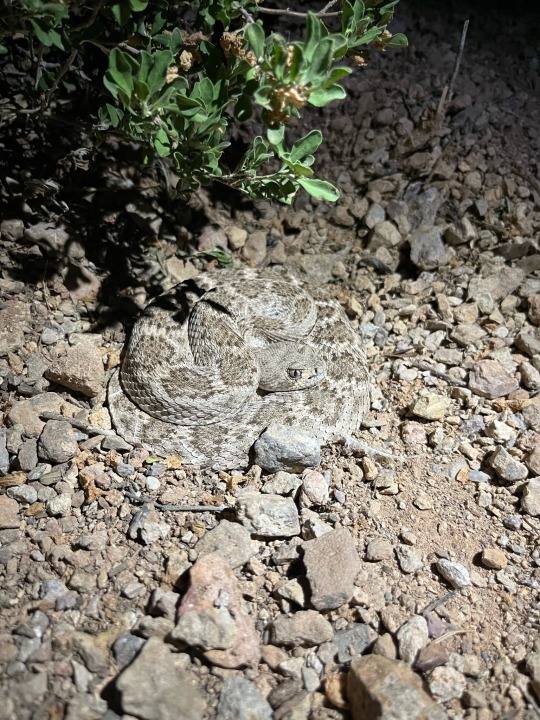
Seen in Tucson, AZ
That is a western diamondback rattlesnake - and this experience really goes to show how tolerant most venomous snakes are of being bothered before they'll try to bite!
I definitely don't mean to scare you at all by saying that this is a venomous snake! There are easy ways to make sure your dogs don't run up on a snake like this again - being careful to avoid potential hiding spots that you can't see underneath (such as close to brushes/shrubs in this case) can help, and when I'm walking my dog when it's dark out, I prefer to carry a flashlight so I can make sure no snakes or other critters are hiding in our path.
326 notes
·
View notes
Text
Miriam is doing some climbing tonight! This picture isn't flipped - this is just how she's choosing to check things out tonight!

515 notes
·
View notes
Note
I raise and breed quail professionally-- would an egg-eating snake be a good pet for me?
Maybe! You'd have to consider all life stages - males and babies are smaller, and need button quail or even finch eggs. If you have year-round eggs, then you might be able to easily feed an adult female!
You'll still have a few logistical challenges, though - it's possible to find captive-bred egg eating snakes, but it's often hard. I never recommend wild-caught pet snakes becuase they're often just riddled with parasites, and if you don't know exactly what to look for, it can be hard to get them healthy.
117 notes
·
View notes
Note
Did you ever hear of Callmethelamp? He owns venomous snakes, like a Gaboon Viper and Boomslang. What do you think of his videos?
Not a fan!
Now, my opinion is that owning snakes with medically significant venom as a private keeper is always unethical. I think it's just irresponsible, even if you know what you're doing (although the people who really know what they're doing will also never own them, so...). Securely housing and providing maintenance for venomous snakes is difficult, and finding veterinary care is even harder. Private keepers who own hot snakes often wind up neglecting them simply because they don't have the knowledge to safely perform regular maintenance (even as simple as changing water bowls), so the snake's needs aren't met as a result.
This guy has so many venomous snakes, I can say with 100% certainty they are not being cared for appropriately. I do a lot of work with a venom lab; taking dozens of venomous snakes to the vet in a day is a logistical nightmare. I am not exagerrating when I say there is literally no way a private keeper could do it. Many vets who will work with venomous snakes and have the experience to do so (which is not a big number to begin with) only work with licensed facilities. If you cannot provide an animal with veterinary care, including regular checkups, then it is unethical to own that animal. Full stop.
I also think his videos are incredibly irresponsible for showcasing private keeping of venomous snakes on the Internet the way he does. A good chunk of snakes at my venom lab came to us from private keepers who thought it would be cool to own them and then surrendered them to a zoo or wildlife center after they had a near-miss with a bite. Not everyone is that lucky. It's wildly irresponsible to act like it's appropriate to keep venomous snakes in your house.
326 notes
·
View notes
Note
Thoughts on scrub pythons as pets?
There's a reason they're not more popular, honestly! They're not difficult to care for, but while I don't own one myself (they're very hard bordering on impossible to find outside of Australia) I have an Australian herp friend who does and he's a cool snake but pretty tricky. Their reputation for having tricky temperaments is not unfounded, they tend to be very defensive in their enclosures. Their personalities aren't that hard to work with but they're so big it can make it much more challenging.
Their size is probably the biggest issue with them! They're about 3ish meters long on average but they can get much bigger, and that can just be a lot of snake. Any snake can can hit or exceed the 10 foot mark is a massive commitment because you have to make sure you're going to be able to house and feed them appropriately - enclosures should be as long as the snake is.
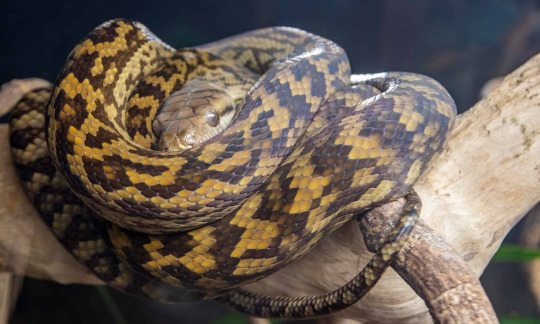
129 notes
·
View notes
Note
I think, now that I have 2 snakes, one of my favorite things is observing the personality differences between them--even as the same breed. Both Phantom and Cosmic Latte love climbing and exploring but they do it so differently. Latte is cautious and methodical, testing each new area to make sure it's safe before he moves on, always keeping his tail hooked around something like a tether just in case he needs to make a quick retreat. And meanwhile Phantom will just throw himself off the nearest counter, desk, chair, bed, etc into the great unknown without so much as checking how high he is first. I have to watch him like a hawk and be ready to catch at all times lol.
It's so much fun to see personality differences between snakes of the same species! Every one is truly an individual. I was just thinking about this because I recently got a new Kenyan sand boa, and his personality is so much different than my older boy. Roswell, my old man, is the sweetest, most docile snake in the world, and my new boy Digby is so high-strung.
112 notes
·
View notes